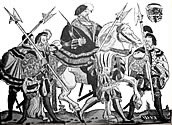Hans Wandereisen
Hans Wandereisen was a wood carver and "war picture reporter" in the 16th century.
Works
Hans Wandereisen carved woodcuts of soldiers and weapons from the 16th century. He became known as a war picture reporter (see also the history of war reporting ) during the punitive expedition of the Swabian Federation against the robber baron Hans Thomas von Absberg .
Woodcuts from 1523
Main article: Wandereisen woodcuts from 1523
In 1523, overpowering troops (allegedly 10,000 soldiers and 1,000 horsemen with 100 rifles, 22 cannons and 900 pounds of black powder) of the Confederation, which consisted of Franconian and Swabian imperial estates, destroyed a total of 23 so-called predatory nests, the owners of which the Absberg destroyed during the kidnapping and extortion of ransom from Had helped merchants. In order to tell the common people, who mostly could not read, about the successes, Wanderisen traveled with them and made important woodcuts of the burning castles for local history research before they were blown up to prevent the owners from returning.
Some of these woodcuts are the only contemporary images of the small castle complexes. Even if they only show these at the time of their destruction, they allow conclusions to be drawn about the appearance and extent of the fortifications from 1523. Numerous castles were not rebuilt and have fallen into ruins. In addition to the main motif, the destroyed castle, which is provided with a short explanatory text, details of the vicinity of the castle are also shown. Although these are not always exactly to scale, as important buildings in the area have been moved closer together for reasons of space, as in Sparneck , they nevertheless allow statements to be made about the location and appearance of the church and monastery or about the settlement structures due to the location of the surrounding farms.
Later authors took up the Wandereisen woodcuts, but in some cases, as by the historical researcher Joseph Baader in the 19th century, the pictures were artistically complemented very freely and the castle complexes were exaggerated with additional floors or additional building parts.
The originally monochrome woodcuts are also known as post-colored drawings. On the one hand, this increased the representational power of the pictures, but in the details incorrect painting led to confusion. Paths or brooks have been painted in wrong brown or blue alternately. The castle "Weytzendorff" (woodcut XIX) could not be located until today (see also Sparneck (noble family) ).
literature
- Joseph Baader : The feud of Hans Thomas von Absberg against the Swabian Federation . Munich 1880.
- Peter Braun: The gentlemen from Sparneck. Family tree, distribution, brief inventory . In: Archives for the history of Upper Franconia . Volume 82, 2002, pp. 71-106.
- Reinhardt Schmalz: The Franconian War 1523 and the guilt of the Sparnecker ; In: Archives for the history of Upper Franconia 85 (2005); Pp. 151-158.
- Thomas Steinmetz: Conterfei a number of acts of war from 1523 to 1527 Jar - to representations of castles about the "Absberg feud" or the "Franconian War" . In: Contributions to the exploration of the Odenwald and its peripheral landscapes IV . Breuberg-Neustadt 1986.
Web links
| personal data | |
|---|---|
| SURNAME | Wanderings, Hans |
| BRIEF DESCRIPTION | Letter painter, form cutter, war picture correspondent |
| DATE OF BIRTH | before 1523 |
| DATE OF DEATH | 16th Century |
